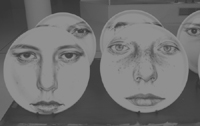Trying to interpret a film of three unconnected stories...
.
Juliette: You might call it an omnibus film.
.
Jacques: Of three stories? No linkages.
.
Juliette: They were all about journeys.
.
Jacques: But none of the journeys had a common theme or country, or
character.
.
Juliette: Right, there were no crossovers, no story referred to one of the
others.
.
Jacques: Difficult to make a film of three stories in three countries by
three directors, wouldn’t you say?
.
Juliette: It has its challenges. Not impossible. But this one was a bit
uneven. Post-modern?
.
Jacques: Even in postmodernism, the narrative needs a coherence of sorts.
You can’t just put three different stories together and grab postmodernism off
the shelf to explain why it was done that way.
.
Juliette: In the Q&A, the directors did seem a bit vague as to how it
came about. “We sat around and thought up some ideas, got funding, went away and
shot footage. Came back, pasted the three stories end to end, and cast around for
a common theme and title.”
.
Jacques: Hmm. Seems a lot of films are made that way. Pressed for theory,
there is a grasping for even a postmodern straw.
___________
Voice-over
 |
| But mother and daughter were persuasive in a traditional Chinese story to scatter ashes on water |
If you were to interpret Journey in terms of post-modernism in film,
several key elements are missing: no genre blending, no reflexivity or
meta-referencing, no fragmentation of time or flashbacks, no mix of high brow
and low brow. Reconceptualized, planned, shot and edited from a postmodern
perspective, this might have had possibilities. But there were likely logistical
constraints, and more than that, the problems of herding three creative
professionals into agreement.
...












No comments:
Post a Comment